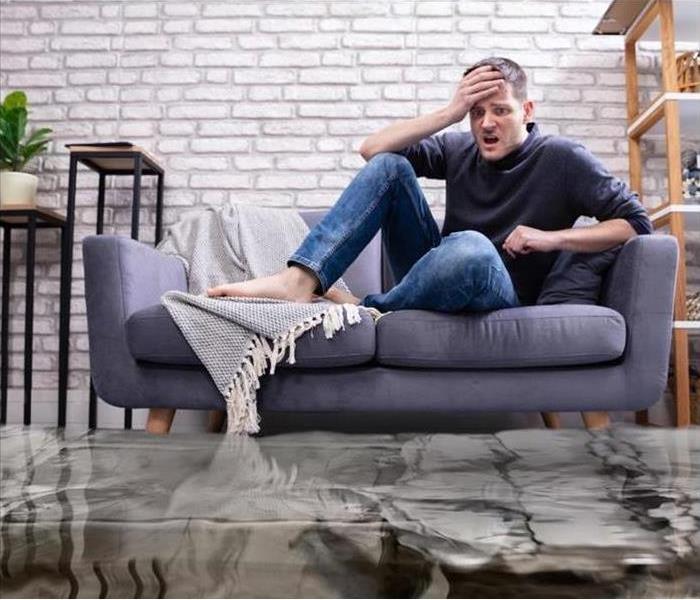Are Water Losses in the Home Permanent?
4/15/2022 (Permalink)
Permanent Losses Can Occur as the Result of Untreated Water Damage. Contact SERVPRO to Mitigate Structural and Contents Loss at Your Wayne Property
Water loss occurs when home appliances malfunction, plumbing fails, or external forces like heavy rainfall lead to large quantities of moisture intruding into the home. Wayne residents may find the quickest solution to potential problems is to use professional restoration technicians. Drying and cleaning a property efficiently can reduce odor, microbial growth, and structural damage. Frequently, contents are restorable and decrease the need for you to source expensive replacements.
When Should I Seek Professional Help for Water Losses?
Once the amount of water damage in your Wayne property goes beyond a reasonable cleaning scope, it is time to bring in professional assistance. Unlike other kinds of property damages, water can get significantly worse in a short period. The timeframe for water losses is particularly sensitive because moisture can interact with and harm structure or contents. It can be overwhelming facing large-scale water loss. SERVPRO technicians are here to put a sound and efficient strategy in place for restoring your property from start to finish.
What Preparation Should I Do Before Restoring Water Damage?
- Set up a clear staging area were for tools and equipment. This staging area helps to make the workload more manageable and prevents you from cross-contaminating other rooms by traveling to and fro for equipment.
- Put in place safety protocols in the house, which is especially vital in loss sites dealing with contamination.
- Create solid engineering controls to avoid spreading water throughout the home. These controls may include establishing de-contamination areas or sealing affected areas of the home. Other engineering controls may consist of foot traffic avoidance in the affected area to prevent contamination from spreading on footwear or clothes
How Do I Stop Water Losses?
The most effective measure of preventing water loss is to extract it from your home as quickly as possible. Extracting water can become complicated if debris, specks of dust, or silts contaminate contents and structure. If large amounts of water are outside the home, for example, in groundwater flooding, then they're a risk of structural collapse from hydrostatic pressure. SERVPRO can control structural harm by pumping out two feet of water with regular cooling-off periods and inspections to ensure there is no loosening of mortar or jointing. We may need to sanitize water before pumping it out of the home to avoid contaminating waste waterways.
What Do I Need to do to Prevent Secondary Water Damage?
Controlling humidity is an essential aspect of any water restoration because it prevents the buildup of microbial bacteria, viruses, and fungi. But high humidity levels can also lead to water migration into unaffected areas of your home. One way to manage humidity is to use negative air pressure. Negative air pressure can be applied with the use of Air Filtration Devices (AFDs) with exhaust ducting set-up through a nearby window or doorway. In most situations, humidity control should be in use once it is safe to bring equipment into the affected area.
What Building Materials get Harmed by Contaminated Water Losses?
- Flooring. Hardwood flooring can frequently be restorable, although carpets, which quickly absorb contamination and water exposure, should be detached and removed from the affected area along with the carpet pads.
- Trim at the bottom of walls like baseboard as well as door and windows can become contaminated quickly but is relatively inexpensive to replace.
- Ceilings and walls may need to be removed after exposure to contamination levels category two and above. Removal can be complicated, requiring razor knives, drywall saws, rotary saws, or Kett saws
- Your heating, ventilation, and air-conditioning systems may become compromised in category two and three water emergencies. In these situations, it is necessary to dissembled for affected components to be containable or removable.
What Can I Salvage From a Water Emergency?
Most valuable contents are salvageable, provided water exposure is limited, and a cleaning or drying procedure is underway. SERVPRO technicians can use high-efficiency particulate air (HEPA) fitted vacuums to remove dry dust or debris from items. Once vacuuming is complete, we may also apply chemical agents to return your items to their pre-damaged condition. We can control the spread of micro-organisms by using disinfectants or appropriate biocides on materials. To avoid causing further harm, our technicians always pre-test chemical cleaning agents on contents to ensure that they do not respond negatively to the cleaning method.
Controlling water losses relies on timely intervention as well as expertise and equipment. To prevent water damage from becoming permanent, contact SERVPRO of Wayne at (973) 546-4977 today.






 24/7 Emergency Service
24/7 Emergency Service
